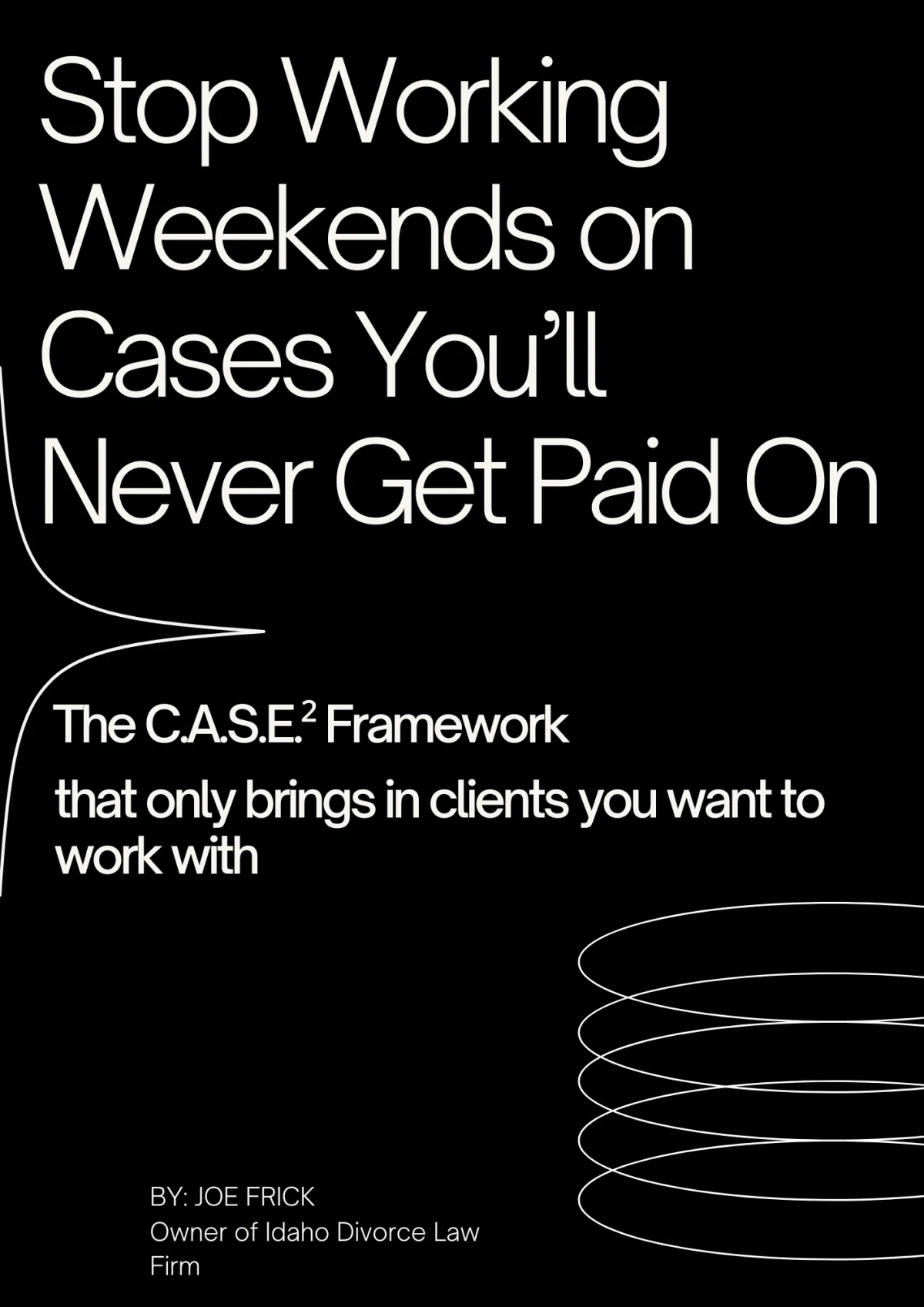Stop Working Weekends on Cases You Will never Get Paid On
Discover the proven intake system that helped me grow my family law firm 40% year-over-year - while doubling net profit and finally reclaiming my weekend

😫 Are You Stuck on the Consultation Treadmill?
Let me guess…

Tire Kickers
You are taking calls with "potential" clients who ghost you the second you quote your fee.

Ungrateful Clients
You’re working on cases that are going nowhere — for clients who stopped paying months ago.

Lost Weekends
Your weekends? Gone. Your evenings? Booked. All in the name of chasing leads who “just need some advice.”

Your Referrals? Drying Up
Because even your best cases can't save a practice running on chaos and exhaustion.
You didn’t go to law school to become a full-time intake coordinator.
But unless you fix your broken intake system, you’ll always be stuck working harder, longer, and with more stress — just to stay afloat.

💣 This Short Book Will Help You Fix That — Fast
Hi, I’m Joe Frick. When I started my family law firm, I made all the mistakes: no screening process, free consultations for anyone who asked, and no idea how to spot a red flag client before it was too late.
I was overworked, underpaid, and dangerously close to walking away.
Then I built a system.
A system that pre-qualifies every prospect before they get near my calendar. A system that tripled our consultation close rate. A system that helped me stop working weekends and start growing my firm like a real business.
That system is inside this book.


📘 What You’ll Get Inside:
The C.A.S.E.² Framework
A plug-and-play method to qualify every PNC before they waste your time.
Intake Scripts That Close
Phone-ready scripts your staff can use TODAY to screen, sort, and schedule the right clients.
The “Saturday Test”
How to spot and avoid the five types of prospects who ruin your week and don’t pay you anyway.
Real-Life Lessons from My Firm
No theory. No fluff. Just the exact systems I use in my firm every day — battle-tested and proven to work.



⏱ In Just One Hour You’ll Learn:
Why “more leads” is not your problem (yet)
The exact question to ask that reveals a tire-kicker instantly
How to command control of intake calls and actually enjoy them
How to protect your time like a 7-figure business owner — even if you're solo

💥 Special Launch Offer:
Get the Book + Templates + Bonuses for Just $9
When you grab your copy today, you’ll also get:
✅ Printable Intake Scripts for your staff
✅ The Saturday Test Worksheet
✅ Free copy of Audio Version of the book (when it is released)
✅ One free month's of access to "The Command" | Frick Factor's Exclusive Family Law Firm Growth Community
$9
🛑 WARNING:
This book won’t help if you’re just looking to hustle harder.
But if you want to start running your firm like a real business — with systems, standards, and sanity — this is your first move.
💡 Still Not Sure?
If all this book does is help you:
Eliminate just one bad client…
Close just one more consultation…
Get back one weekend with your family…
…it’ll have paid for itself 100x over.
🛒 Grab Your Copy Now for Just $9
Get the Book + Templates + Bonuses for Just $9
[ ✅ YES – I Want the Book & Bonuses ]
You'll receive the digital copy instantly, along with all bonus materials and scripts.
🔥 Want to See This System in Action?
On the next page, I’ll offer you a $1 trial to the Command Post Community — where I teach you how to build the same strategic systems I used to grow a family law firm with real profit, real clarity, and real time freedom.
But first — grab the book.
Because your next bad consultation doesn’t just cost you money… it costs you your time, your focus, and your future.
© Copyright 2025. Lawyer Secrets Marketing, LLC. 250 S. 5th St., Suite 302, Boise, ID 83702. All rights reserved.